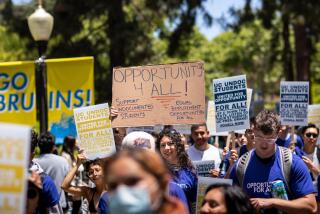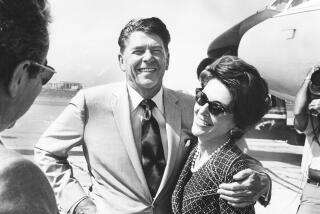As young governor, Brown went his own way
Reporting from Sacramento — GOP gubernatorial nominee Meg Whitman paints rival Jerry Brown as a machine Democrat who as governor decades ago spent big and coddled liberal interests while pursuing an expansive role for government. Brown says he was a deficit hawk who deftly managed the state’s finances and a world-class educational system.
Neither of the conflicting portrayals, featured in the battle the two have been waging on California’s airwaves, is exactly how those eight years went.
Brown disdained political convention and protocol and refused to govern as a run-of-the-mill liberal. He tangled with the Legislature constantly, though it was controlled by fellow Democrats: Lawmakers overrode his vetoes 12 times. And although his early approval rating hit 85% — higher than Ronald Reagan’s had reached — Brown ultimately tripped over his famous frugality, irritating voters by squeezing local schools, delaying road construction and neglecting the growing state university system.
“He had his own ideology, and it was one we had never seen before,” said Paul Priolo, who was the Assembly Republican leader during part of Brown’s governorship. “He was different.”
Brown had many successes, and several of his ideas — carpool lanes, satellite communications for California, computers in classrooms —- are commonplace now. He was the skilled dealmaker who, at 37, negotiated the landmark farm labor agreement that ended the nationwide produce boycotts. He protected some of the state’s most pristine lands and crafted energy policies that sowed the seeds of a green economy long before it was stylish.
But he was also the distracted intellectual who dawdled as soaring property taxes began to crush homeowners, spurring a ballot box revolt. He was paralyzed by the Medfly crisis and criticized for being inattentive to schools.
He recruited a dynamic group of Californians to run the government, spurning the usual insiders and filling many prominent positions with women and minorities for the first time. Some of them helped usher in such pioneering policies as a 25% reduction in air pollution and pressured Detroit for more environmentally friendly cars.
Others flailed. Rose Bird, the ardent death penalty opponent with no judicial experience whom Brown appointed as chief justice of the Supreme Court, was ultimately rejected by a 2-1 margin in a regularly scheduled retention vote.
Lawmakers were inclined to dislike Brown from the start. He came into office on the heels of a successful initiative campaign to ban lavish gifts from lobbyists to politicians. Lawmakers had earlier rejected Brown’s “two hamburgers and a Coke” proposal, inspired by his view that that’s about all a lobbyist should be allowed to buy a lawmaker.
The state Senate leader once ordered the sergeant-at-arms to halt an impromptu Brown press conference in Senate chambers and threatened to have state police forcibly evict him. By Brown’s second term, his bill vetoes were overridden so often that it appeared lawmakers were doing it for sport. No governor since has been overridden.
Sometimes it seemed like Brown was winging it — as he appears to be these days on the stump. His distaste for plans and pamphlets, policy agendas and schedules dates back decades.
“Often we have to just let things emerge,” Brown said in an interview with Playboy in 1976. “If you’re interested in agendas, you might read the inaugural speeches of the last five governors. They say much the same thing: Down with crime, unemployment and taxes.”
Brown had kept his inaugural speech to seven minutes. He talked about unemployment. Then he took a group to Man Fook Lo, a Chinese restaurant in the produce district of Los Angeles. No inaugural ball.
But liberals attracted by Brown’s progressive outlook and family legacy of big projects — his governor father, Pat Brown, built universities and freeways — were disappointed. Brown’s frugality went beyond his rented apartment with a mattress on the floor; he declared an “era of limits” and tightened the state belt even as a record state surplus mounted.
Former Gov. Gray Davis, Brown’s first chief of staff, said Brown suggested senior government staffers save taxpayers money by staying with friends when traveling instead of in hotels.
“His Department of Finance would hide money from us,” said Richard Robinson, a Democrat who represented the Santa Ana area in the Assembly. “It was a major source of frustration.”
Some programs suffered. California slipped from 18th to 31st in the nation, by some measures, in per-pupil school spending. Brown suggested that cutting off some funds for schools would inspire reform. Instead, the school day was shortened, classrooms grew crowded and teachers’ salaries fell behind those in other states.
At the state’s universities, faculty salaries were frozen. Brown said highly compensated state employees such as university professors were deriving “psychic income” from the interesting nature of their work. He vetoed raises for other state employees and curbed spending on transportation, leaving much of the freeway system, a Pat Brown legacy, to deteriorate.
The junior Brown did sign off on construction of the 105 Freeway. But mostly he focused on alternative transportation. He appointed Adriana Gianturco, a 36-year-old Bostonian with no background in highway engineering, to run Caltrans. She had opposed the 105 Freeway, rejected plans for another expressway and transformed the fast lanes on the Santa Monica Freeway into “diamond lanes” for carpoolers.
Drivers grew enraged. They sat in choked lanes of traffic while the underutilized diamond lanes were clear. People called Gianturco the Giant Turkey, the Madwoman of Caltrans, Our Lady of the Diamond Lane.
Los Angeles officials, including then-City Councilman Zev Yaroslavsky, filed a federal lawsuit that forced Gianturco to retreat.
“He got off into what we thought were some pretty weird ideas,” said Priolo. Among them were power-generating windmills and the use of agricultural waste such as wood chips and walnut shells to heat the Capitol. “We used to call him ‘Woodchips and Windmills,’ ” Priolo said. “In retrospect, he had some ideas that came to fruition. Or if they haven’t, they probably will.”
The Capitol is not yet heated by woodchips. But power-generating windmills can be found across the state. Brown pushed for solar energy tax credits — available today for homeowners and businesses. He created the California Conservation Corps, a program that put young people to work maintaining parks and responding to natural disasters.
One of Brown’s proudest achievements came early in his administration, when the young governor helped labor leader Cesar Chavez win organizing and bargaining rights that had never been granted to farmworkers in this country. Brown built a fragile coalition of agriculture companies, other business interests, union leaders and politicians to push those rights through the Legislature, ending a nationwide boycott of grapes and lettuce as well as farmworker strikes, fasts and protests that had become violent.
Brown stumbled, though, in his handling of other crises.
Late in his second term, as the Mediterranean fruit fly wreaked havoc on farms and orchards, he seemed paralyzed. Agricultural interests said the pesticide malathion had to be sprayed to save the economy, while environmentalists said the chemical was dangerous.
Brown eventually approved the spraying, but only after the federal government threatened to quarantine California crops. Brown explained his hedging in a 1989 interview with The Times.
“The medical studies of malathion make it seem OK,” he said, “but when it takes the paint off your car, you have to pause and think: Do we know enough? Is there a safer way?”
Brown’s biggest fumble came as taxpayers’ anger grew amid rising property assessments and he failed to move swiftly to provide relief.
He dismissed Proposition 13, the proposal to drive down property taxes, as “consumer fraud” and its best-known champion, Howard Jarvis, as a “demagogue.” Voters felt otherwise, and by the time Brown and lawmakers acted, it was too late: The alternative tax relief proposal they placed on the ballot alongside Proposition 13 failed. Jarvis’ measure received 65% support.
Proposition 13 threw state finances into perpetual tumult by changing the flow of revenue between the state and local governments. It threatened to bankrupt municipalities, and Brown — who set about enforcing the new law of the land — spent years working with the Legislature to spend the state’s surplus to bail them out.
Jarvis was so pleased by Brown’s implementation of the measure that he endorsed the governor’s bid for a second term.
More to Read
Get the L.A. Times Politics newsletter
Deeply reported insights into legislation, politics and policy from Sacramento, Washington and beyond. In your inbox three times per week.
You may occasionally receive promotional content from the Los Angeles Times.











